

In this rewarding present perfect error correction activity, students review the correct use of the present perfect by finding errors in affirmative and negative sentences, and questions. First, students read the sentences and questions on the worksheet, some of which contain errors in the use of the present perfect. If students think a sentence is right, they put a tick. If they think it's wrong, they put a cross. Next, students bet between 10 and 100 points on each item, depending on how confident they are about their decisions. Afterwards, check the answers as a class. If students guess correctly, they win the amount they bet. If they guess incorrectly, they lose that amount. The student with the highest total at the end is the winner.



In this useful present perfect worksheet, students learn how to use the present perfect tense to talk about finished and unfinished actions or events and their related time expressions. First, students read how the present perfect is used to talk about finished actions or events. Students then read sentences, focus on the time expression, and decide if each sentence is right or wrong. Next, students read how to use the present perfect to talk about unfinished actions or events. Students then read sentences and write 'finished' or 'unfinished'. After that, students use their own ideas to write two present perfect sentences about their own life experiences and two sentences about unfinished actions or events in their lives. Next, students read a list of finished and unfinished time expressions and put them into the correct category. Afterwards, students write sentences in the present perfect using prompts and unfinished time expressions. Finally, students write true present perfect sentences about themselves using unfinished time expressions and discuss them with a partner.
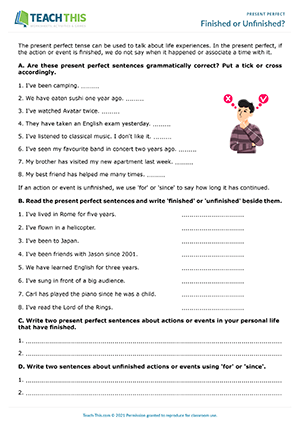


This fun present perfect game helps students practice present perfect yes/no questions and short answers. In groups, players take turns choosing one of their short answer cards without showing it to anyone, e.g. 'Yes, it has.' The player then thinks of a present perfect yes/no question that will elicit the answer on the card, e.g. 'Has it been sunny today?' The player then asks the question to another student in the group. If the student gives the same short answer that's on the card, the player wins and discards the card. If not, the player keeps the card. The first player to get rid of all their cards wins the game.



In this entertaining present perfect miming game, students guess present perfect sentences about recent events from mimes. Students take turns picking up a card. A group member then asks the student 'How have you been?' The student replies with either 'Pretty good' or 'Not too good', depending on whether their card represents good news or bad news. After that, the student mimes the present perfect sentence on their card using actions and gestures, and the other students try to guess the news. The first student to say the present perfect sentence on the card wins and keeps the card. The student with the most cards at the end of the game is the winner.
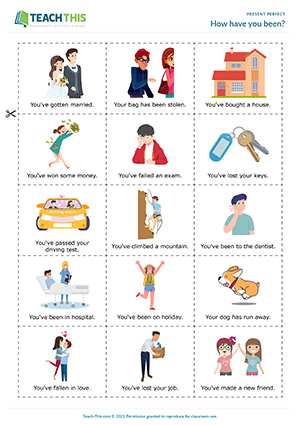


In this engaging present perfect activity, students write about things they have and haven't experienced and then discuss their answers with a partner. Working alone, students complete sentences on their worksheet with true information about things they have and haven't experienced, e.g. 'I have never tried Indonesian food, but I have tried Vietnamese food.' In pairs, students then take turns reading each sentence to their partner. After a student has read a sentence, their partner asks the student follow-up questions to find out as much information as possible. This continues until all the sentences have been read and discussed. Afterwards, students share what they found out about their partner with the class.



In this interesting present perfect speaking activity, students ask and answer questions about life experiences using been. Working alone, students write one follow-up question for each Have you been question on their worksheet. In groups, students then find out who answers 'yes' to the Have you been. questions. One student asks the first question to the group, e.g. 'Have you been camping?' All the students write down the names of anyone who answers yes. Each student in turn then asks their follow-up question to find out as much information as possible. Another student then asks the second question and, so on. When everyone has finished, each group reports their findings to the class using the present perfect with been, e.g. 'We’ve all been camping. Most of us have been camping in a field, but Amelia has been camping on top of a mountain. '



In this enjoyable present perfect game, students race to put words in the correct order to make present perfect sentences about a love story. This game helps students practice present perfect sentence structure and word order. Teams race to put the words in the first sentence on their worksheet in the correct order, adding in any necessary punctuation and correcting any grammar mistakes. The first team to show and read out the sentence in the correct order scores three points. Teams that show or read out a wrong answer lose one point. This continues until all the sentences have been completed. The team with the highest score at the end of the game wins.
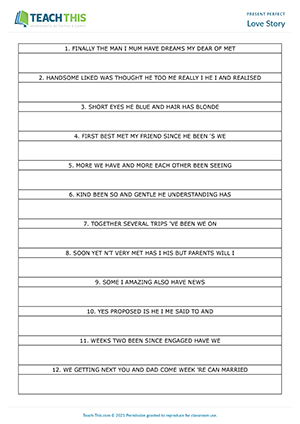


In this entertaining present perfect game, students play snap by matching Have. and Has. questions with short answers. In pairs, both students turn over a card from their pile at the same time and place them on the table next to each other. If the present perfect yes/no question and short answer match, the first student to say 'Snap!' scores a point. Students then pick up their own cards, shuffle their pack and play again. Students do not pick up their partner's cards. If the question and answer don't match, students continue turning over cards until a matching pair comes up. If a student says 'Snap!' when the question and answer don't match, the other student scores a point and the game continues. The first student to get 15 points wins the game.



In this fun present perfect game, students play bingo by asking and answering Have you questions. Students go around asking their classmates present perfect Have you. questions from the squares on the bingo grid. If a square relates to a personal experience, students make a question with Have you ever. When a classmate answers 'Yes, I have' to a question, the student writes their name in the square and then moves on to speak to another student. If a classmate answers 'No, I haven't', the student asks a different question or goes on to speak to someone else. The first student to get five squares in a row in any direction shouts 'Bingo!' When this happens, stop the activity and have the student make five present perfect sentences about the information in the squares, e.g. 'Becky has flown a kite. Derek has been on a long flight, etc.' Then, students continue the game by trying to complete the entire bingo card with names.



In this free present perfect Wh questions worksheet, students learn the functions of question words and how to form, ask and answer Wh questions in the present perfect tense. First, students fill in gaps with words from a box to explain the functions of question words. Next, students complete present perfect questions with suitable question words from Exercise A and write a response to each question. Students then practice writing present perfect Wh questions using prompts. After that, students write present perfect Wh questions corresponding to the underlined information in responses. Finally, students ask and answer the questions in Exercise D with a partner.



In this fast-paced present perfect time expressions game, students race to make sentences and questions with time expressions that are associated with the present perfect tense. Invite one student from each team to come to the front of the class. Show the student a time expression associated with the present perfect. The two students then race to make a present perfect sentence or question using the time expression. The first student to do this successfully scores a point for their team. If a student makes a grammar mistake, they are out. If both students cannot make an appropriate present perfect sentence or question, they are both out. After that, two new students come up to the front of the class, and so on. The team with the most points at the end of the game wins. Afterwards, write the time expressions on the board. Students then write down a present perfect sentence or question for each time expression. Finally, in pairs, students check each other's work and suggest improvements or corrections.
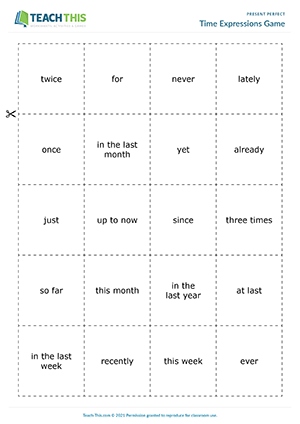


In this insightful present perfect speaking activity, students write, ask and answer present perfect Wh conversation questions. First, in two groups, students write present perfect conversation questions from prompts. Students then pair up with someone from the other group. Next, students take turns asking the present perfect questions to their partner, noting down their answers and asking follow-up questions to gain more information when possible. Finally, students report back to the class on the things they found out about their partner.



In this intriguing present perfect speaking activity, students discuss how things have changed in the last ten years. First, students look at topics in a box and think about how the things have changed in the last ten years. Students then write their answers in the a lot, a little, or no change columns in the chart, making notes to justify their answers. Next, students use the present perfect to interview a partner and complete the second chart with their answers, e.g. A: How do you think banking has changed in the last ten years? B: I think banking has changed a lot. Online banking has become very popular, etc. Finally, in groups, students discuss the topics they put in different columns.
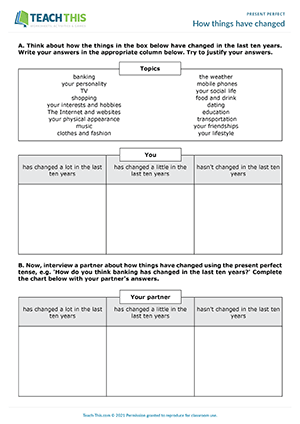


In this handy present perfect speaking activity, students practice talking about their life experiences. First, students answer 12 questions on their worksheet by writing short answers in a random order in the boxes. Students then swap worksheets with a partner and look at the short answers their partner has written. Next, students take turns asking their partner why they have written the words in the boxes, e.g. 'Why have you written the word ‘charity’?' Their partner replies using the present perfect, e.g. 'I have spent a lot of time raising money for charity. It's something I’m very proud of.' The other student then asks their partner follow-up questions to gain more information, e.g. 'What charity have you raised money for?' When everyone has finished, students report back to the class on the most interesting or surprising things they found out about their partner.



In this present perfect information gap activity, students write and ask present perfect questions with has in order to complete a text about a dancer. First, in two groups, students write down the present perfect yes/no questions with has that they need to find out the missing information in a text about a dancer. Next, students pair up with someone from the other group and take turns asking and answering their questions in numerical order. If their partner responds with 'Yes, she has', the student writes have in the space. If they reply with 'No, she hasn't', the student writes have never in the space. Afterwards, students compare their completed texts, which should be identical..
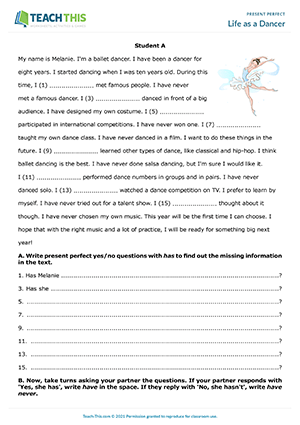


Here is an excellent present perfect board game to help students practice talking about various topics in the present perfect tense. In groups, students take turns rolling the dice and moving their counter along the board. When a student lands on a square, they talk about the topic on the square in the present perfect tense for 30 seconds without stopping. If a student can’t think of anything to say, makes a grammar mistake or stops talking before the 30 seconds are up, they go back two squares. The first student to reach the finish wins the game.



In this productive present perfect worksheet, students revise the various uses of the present perfect tense and related vocabulary. First, students complete sentences with words related to the present perfect tense. Next, students answer grammar questions about the sentences by writing the sentence numbers. Students then use the present perfect related words to complete grammar rules. After that, students write sentences about themselves using just, already, yet, for, since and never. Students then write three questions to ask about a partner's life experiences using ever. Afterwards, students ask and answer the questions with a partner. When the students have finished, they tell each other more about themselves using their present perfect sentences. Finally, students share what they found out about their partner with the class.
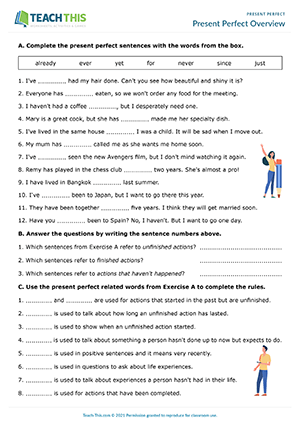


In this free present perfect speaking activity, students discuss travel questions in the present perfect to find out who is the most experienced traveller in their group. In groups, students review the items on the worksheet and prepare the travel questions they are going to ask each other, e.g. 'How many countries have you been to?' Students then discuss each question in turn using the present perfect and write their answers in the column next to the questions. When the students have finished, they look at whose name has been written the most and complete the text at the bottom of the worksheet to explain who is the greatest traveller in their group and why. Afterwards, each group gives feedback to the class on their results.



In this creative present perfect activity, students write true and false sentences about what they have and haven't done in their lives and then play a guessing game using the sentences. First, students complete 20 sentences with verbs in brackets in their present perfect form, making half the sentences true and half false. Next, in pairs, one student goes first and reads the first sentence to their partner, who asks past simple follow-up questions to find out if the sentence is true or false. After a few questions have been answered, their partner makes a guess and the answer is revealed. Their partner scores one point for each correct guess. Afterwards, students swap roles. The student with the most points at the end of the game is the winner. Finally, in groups, students look at the sentences about experiences they haven’t had and say which things they want to do and which they don’t want to do, giving reasons why or why not.



This amusing present perfect passive game helps to teach students how to use the present perfect passive to talk about things that have changed. Students begin by memorizing the position and state of everything in the classroom for two minutes. A student from Team A then leaves the room for one minute. During that time, the other students change five things in the room. The student then comes back in and tries to identify what has been changed by making present perfect passive statements, e.g. 'The lights have been switched off.' The other students listen carefully and confirm or deny the changes. The student scores one point for their team for each correct answer. A student from Team B then leaves the room, and so on. The team with the most points at the end of the game wins.



In this comprehensive present perfect review worksheet, students work through various exercises and texts to review different structures in the present perfect tense, including active and passive voices. Students begin by completing sentences with present perfect related words from a box. Next, students answer questions in sentence form using the words from the box in Exercise A. Students also write one more present perfect question of their own at the end and answer it. After that, in pairs, students ask and answer the questions with their partner. Students then underline ten mistakes in a text and write the corrections. Finally, students complete a text with verbs from a box in the present perfect tense, in either the active or passive voice.